We think of "The Great Depression" in terms of the United States. It was actually a worldwide economic depression, However, the starting factor was the collapse of the New York Stock Exchange on October 29, 1929 known as "BLACK TUESDAY".
Between 1929 and the end of 1932 there were four major economic indicators that illustrate the impact of the Depression on the World. Below is a chart of the negative impact on the four major areas at the time. As will be clearly seen the United States felt it the most. In Germany these conditions would lead to the rise of Adolph Hitler and the Nazi Party.
United States United Kingdom France Germany
Industrial Production -46% -23% -24% -41%
Wholesale Prices -32% -33% -34% -29%
Foreign Trade -70% -60% -54% -61%
Unemployment +607% +129% +214% *232%
There are other factors leading to the Depression, but they were minor compared to what the above chart reflects.
There have been two theories attempting to explain the economic impact on the world:
Keynesian
British economist John Maynard Keynes argued that to keep people fully employed. A government must run deficits when the economy is slowing down, because the private sector will never invest enough money to keep the economy out of recession.
Monetarist
American economists Milton Friedman and Anna J, Schwartz argue that the Depression was caused by the banking crisis. That resulted in the disappearance of one-third of the major and minor banks across the World and the reduction of bank shareholders. The two economists called this "The Great Contraction".
The actual Depression lasted for ten years from 1929 to 1939. This article came about partly because as I was writing it. The United States had the worse December New York Stock Market losses since December 1933. The entire year of 2018 ended with the market at a point equal to ten years earlier. With economists believing constant fluctuation may continue lowering the market even more with a possibility of a recession. Depending upon when my reader reads this article, if at all. They can determine, if the economists were correct.
Whatever the cause and explanation "The Great Depression" impacted American's as indicated above by an increase in unemployment of 607 percent. Entire families, including several generations, started migrating from one state to the next looking for work. Entire small rural communities vanished and crime went up. Creating such names as John Dillinger, Lester Gillis aka:"Baby Face" Nelson and Bonnie Parker and Clyde Barrow. While the FBI hunted down these bank robbers and killers. They became folk heroes to many Americans searching for anything to take their minds off their own situation.
Hollywood decided to help get the public's minds off their economic worries and make a little money in the the deal. So, besides "B" Westerns motion pictures starring the likes Gene Autry, John Wayne and Bob Steele. The industry started using the new medium of sound to turn out musicals. The most famous were by Director Busby Berkeley. Three of his pictures were from 1933. These hits are "Gold Diggers of 1933" featuring Ruby Keeler, Ginger Rodgers and Dick Powell, "42nd Street" featuring the same three performers. While "Flying Down to Rio" first teamed up Ginger Rodgers and Fred Astaire.
Horror movies became popular. These titles contained Universal Studio's 1931's "Dracula" with the original stage actor, Hungarian, Bela Lugosi. That same years "Frankenstein" turned unknown British actor Boris Karloff into a star. 1932 saw another British actor, Claude Rains, become the H.G. Wells' "The Invisible Man", because of his distinctive voice. Before she was Ann Darrow in 1933's "King Kong". Movie audiences saw Fay Wray as the heroine in the first two all Technicolor Horror movies. They were Warner Brothers 1932 "Dr. X" and 1933's "The Mystery of the Wax Museum".
Hollywood also started turning out morality tale crime films. Three major titles are 1931's "Little Caesar" starring an unknown Edward G. Robinson. The same years "Public Enemy" starring Busby Berkeley's song and dance man James Cagney and in 1932 the original "Scarface". That feature starred Paul Muni and was partly Directed by producer Howard Hughes and mostly Directed by Howard Hawks.
From 1957 to 1961 Independent Studios went back to those Depression Era Criminal Folk Heroes in a series of low budgets movies. My article on these films vs reality can be read at:
http://www.bewaretheblog.com/2016/01/1957-to-1961-hollywood-gangster-motion.html
Some of those morality tales being turned out during the actual Depression Era were not about gangsters. One such motion picture looked at the problems facing teenagers.
WILD BOYS OF THE ROAD released October 7, 1933
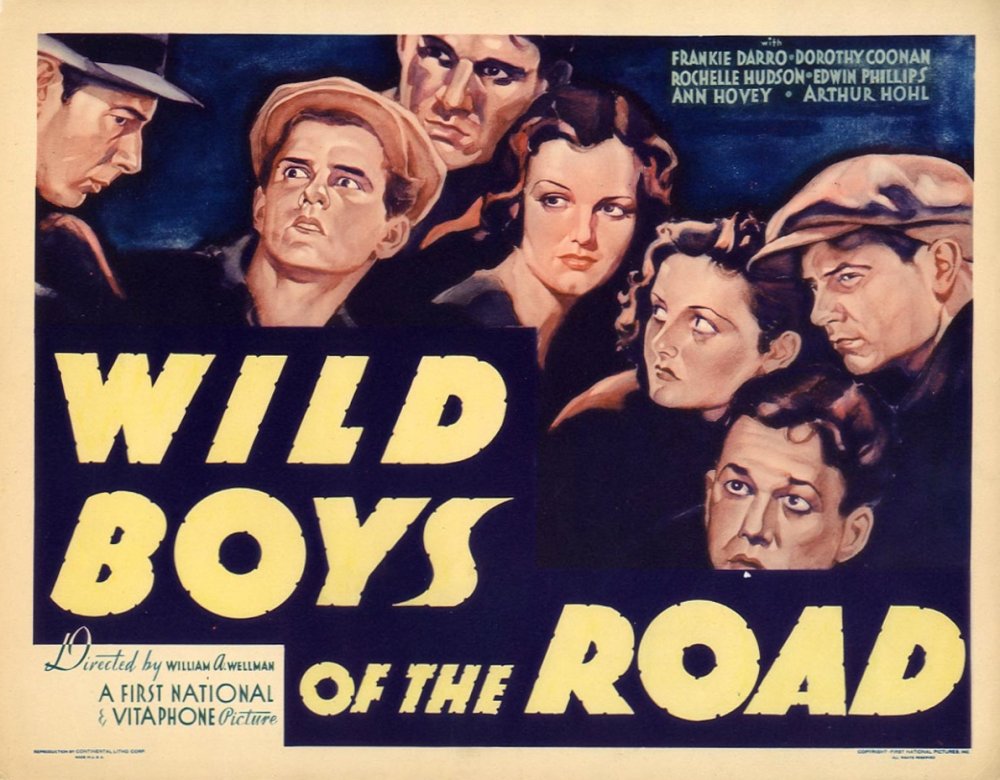
In 1927 William A. Wellman directed the first motion picture to win what became the "Best Picture" Academy Awards "Wings". Ten years later he wrote the original story for the first version of "A Star Is Born" and received an Oscar. He also was the Director of that motion picture. In 1943 Wellman would Direct the classic Western "The Oxbow Incident" starring Henry Fonda and Dana Andrews. In the first half of the 1950's he would Direct John Wayne in "Blood Alley", "Island in the Sky" and "The High and the Mighty". My article on Wellman and the three John Wayne movies may be read at:
http://www.bewaretheblog.com/2017/07/william-wild-bill-wellman-3-with-john.html

Between "Wings" and "A Star Was Born" were 35 other features including James Cagney as "The Public Enemy", Clark Gable and Loretta Young in an excellent version of Jack London's "The Call of the Wild" and this film "Wild Boys of the Road".
The original story concept was by Daniel "Danny" Ahern. Who has only three pictures to his credit and in the same year this feature was released. Ahern had created the story for James Cagney's forgotten "Picture Taker".
Earl Baldwin turned Daniel Ahern's story into the screenplay Director Wellman worked from. Among Baldwin's other work was the first all Technicolor Horror movie "Dr. X". That would star Lionel Atwill , Fay Wray and Preston Foster. Another of his screenplays was the James Cagney, Pat O'Brien "Devil Dogs of the Air". Additionally, Baldwin, wrote the screenplay for James Cagney's "The Roaring Twenties". Which co-starred Humphrey Bogart.
This story and screenplay was about teenagers becoming Hoboes and riding the rails. Quoting from the website "Wessels Living History Farm", about Depression Era Hoboes, is the following opening to the article:
https://livinghistoryfarm.org/farminginthe30s/water_07.html
Many people forced off the farm heard about work hundreds of miles away ... or even half a continent away. Often the only way they could get there was by hopping on freight trains, illegally. More than two million men and perhaps 8,000 women became hoboes. At least 6,500 hoboes were killed in one year either in accidents or by railroad "bulls," brutal guards hired by the railroads to make sure the trains carried only paying customers. Finding food was a constant problem. Hoboes often begged for food at a local farmhouse. If the farmer was generous, the hobo would mark the lane so that later hoboes would know this was a good place to beg.The Main Characters of the story are:
"Eddie Smith" portrayed by Frankie Daro. Sixteen year old Daro had been acting since 1924. He became popular in "B" Westerns and Dramas. He appeared in the 1935 serial "The Phantom Empire" in which Gene Autry fought the survivors of the Lost Continent of Mu. He moved to television in the 1950's and here's a piece of trivia. Frankie Daro was the man inside "Robby the Robot" in 1956;s "Forbidden Planet", His last role was as "Lester the Drunk" in the forgotten 1975 motion picture "Fugitive Lovers".
Edwin Phillips portrayed "Tommy Gordon", I could find no real information on Phillips and he only appeared in two other motion pictures. The second was 1935's "Soak the Rich" and the third wasn't until 1954. This was the musical "Satin and Spurs" starring Betty Hutton of "Annie Get Your Gun" and Cecil B. DeMille's "The Greatest Show on Earth".
Dorothy Coonan portrayed "Sally" and had appeared in several Busby Berkeley musicals.Shortly after this motion picture she married William Wellman and the two would be married and stay married until his death.
Below left to right are Frankie Daro, Edwin Phillips and Dorothy Coonan,
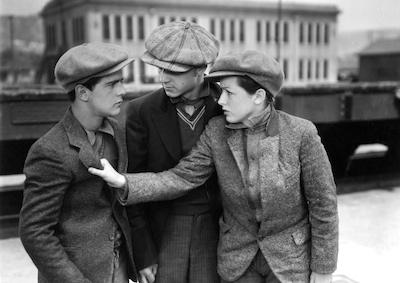
Rochelle Hudson portrayed "Grace". Over her 112 screen credits ending in 1967. Hudson voiced the girlfriend "Honey" of the extremely popular Depression Era cartoon character "Bosko". He was one of the first "Looney Tunes" and today is considered extremely racist. Hudson also appeared in the Mae West and Cary Grant picture "She Done Him Wrong", portrayed Claudette Colbert's daughter in the 1934 film "Imitation of Life", was "Cosette: in the classic 1935 version of Victor Hugo's "Les Miserables" starring Fredric March and Charles Laughton and would switch to television in 1951. More interesting was that in 1942 she and her then husband went on a vacation trip to Mexico, but in reality they were spying for America to confirm reports of a German spy network operating at the U.S.-Mexico border.
Below Rochelle Hudson and Edwin Phillips

The plot of "Wild Boys of the Road" reflected the situation facing many American families. "Tommy Gordon" has decided to drop out of High School. Not because he doesn't want an education, but to help his family. "Tommy" starts looking for work, but can't find any and learns his father has just been laid off.
"Tommy" makes the decision to sell his car and give that money, from the sale, to his father. However, the bills just keep building on the family. A plight that the audience knew all too well.
That 1933 audience paid and average price of 51 cents for an Adult Movie Ticket. The cost of such a ticket started declining as the depression continued and audiences attendance was also decreasing. By 1939 that Adult ticket price was an average of 19 cents.
"Tommy" talks to his best friend "Eddie". Whose in a similar circumstance with his family and the two young boys decide to leave home to ease the burden on their respective families. The got to the train tacks and jump onto a freight boxcar.

On the train the two boys meet "Sally". She is heading for Chicago in the hopes that her Aunt will put her up. On the way they have to jump from the train and meet others teens in similar situations. Below is a cast publicity photo.

When the three reach Chicago. They discover that the unemployed crisis has reached there too, but they head to "Sally's" "Aunt Carrie's" house. Only to discover "Aunt Carrie's House" is in really a brothel with many young women working there because of the hard times. "Carrie" does put them up until her place is raided. The Trio now hit the rails again heading for Columbus, Ohio. At this point "Eddie", "Tommy: and "Sally" have no plans of were to actually go. Like hundreds of others they will let the train rails take them from town to town.
Below, one of the other girls they meet is "Lola" portrayed by "Ann Hovey".She is alone in one of the Freight Train's box cars when "Red," the train brakeman, finds and rapes her.
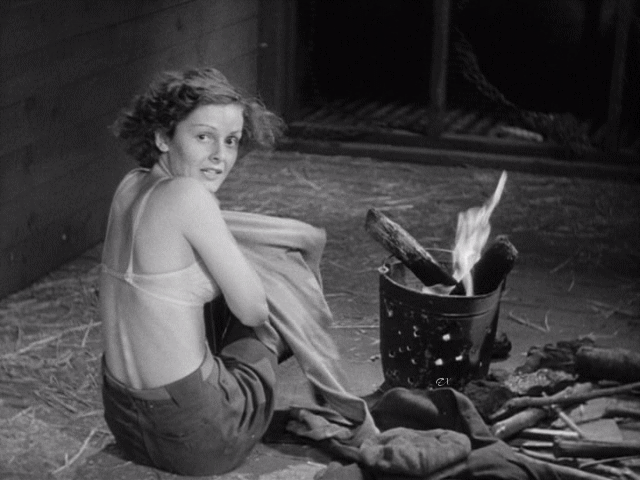
The brakemen was portrayed by a non on screen credited Ward Bond. The boys of the group then take revenge upon "Red".

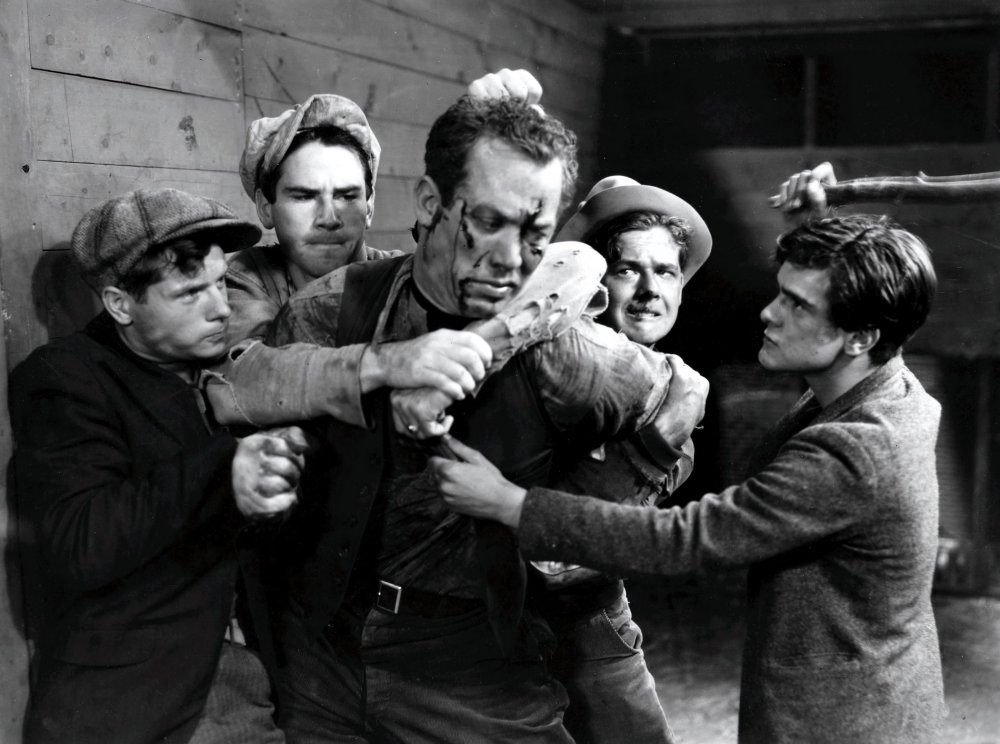
"Red" falls out of the boxcar to his death. As the train approaches the city everyone jumps off it so as not to be caught by the police and Railroad "Bulls". Unfortunately, as he jumps, "Tommy", hits his head on a track switch and lands on the tracks. He starts to crawl to safety from an oncoming train, but doesn't make it and his foot is run over. It will have to be amputated as a result of the accident.

The three young people, just trying to survive, now live in a Depression Era camp called "Sever Pipe City" near Cleveland, Ohio.
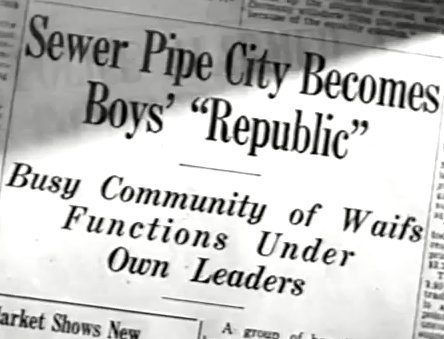
For awhile it seems things are going fine, but then the authorities decided to shut the "City" down. This is a result of "Eddie" stealing a badly fitting prosthetic leg for "Tommy". So with "Sally" the boys jump on another train and move toward the East coast. They finally are seen living in the New York City Dump.
"Eddie" has found a job, but needs three dollars, money he doesn't have, to buy a coat to wear. Two panhandlers offer him five dollars to deliver a note to the movie theater cashier across the street from where the three are standing. "Eddie" makes two mistakes. The first is not reading the note and the second is to blindly trust the two men. He goes to the cashier:
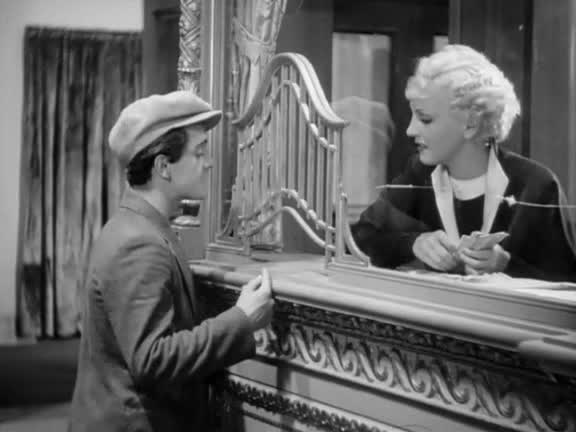
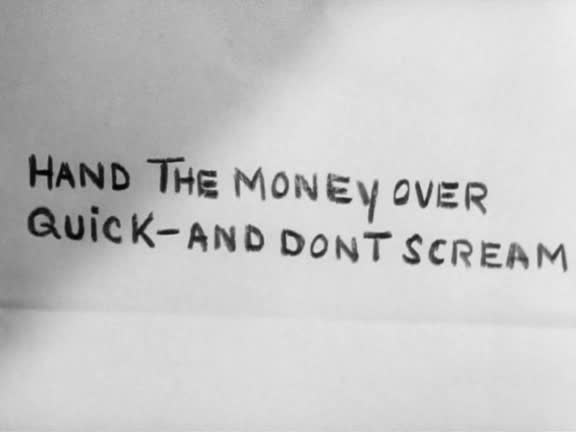
She screams and seeing two police officers. "Eddie runs into the theater and is arrested for attempted robbery.
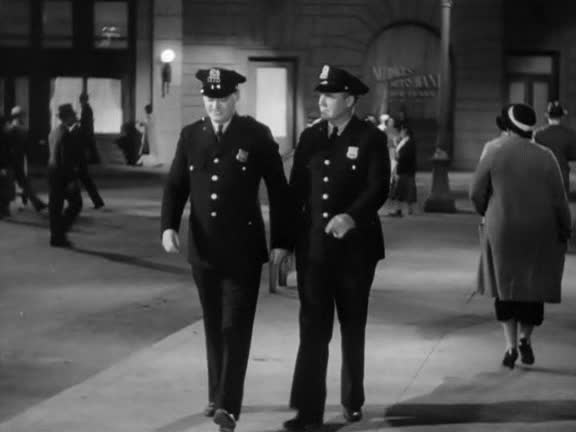
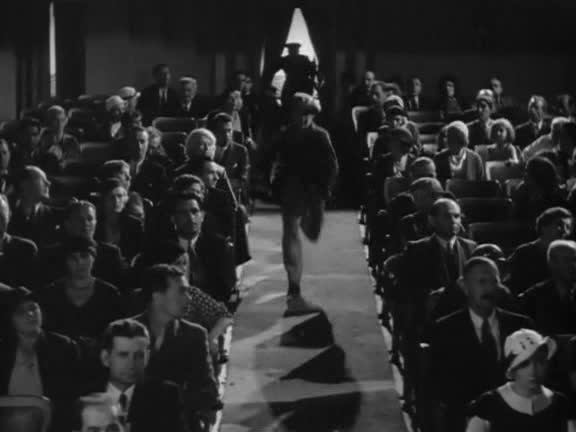
When "Sally" and "Tommy" protest "Tommy's" arrest to the police officers. The two are arrested also and all three go before a Judge

This turns into the "Happy Ending". Although the Judge can not find out any information from the three about their parents, or where they originally came from. He dismisses the charges against "Eddie" and will help him get his job back. He also promises the three that their parents will be back to work soon. One of the messages of hope placed into movies made during the Depression. Warner Brother's goal was to attempt to scare young people from "Riding the Rails".

THE GRAPES OF WRATH premier in New York City January 24, 1940
Before, I discuss the classic motion picture with seven Academy Award nominations and two wins for Best Director John Ford and Supporting Actress Jane Darwell. I want to speak to John Steinbeck and his novel published April 14, 1939.


According to the website "greenleft weekly:
https://www.greenleft.org.au/content/long-retreat-john-steinbeck
John Steinbeck was quoted as saying his motivation for the novel was:
I want to put a tag of shame on the greedy bastards who are responsible for this [the Great Depression and its effects]. I've done my damnedest to rip a reader's nerves to rags.The novel's title came from Julia Ward Howe's Battle Hymn of the Republic:
Mine eyes have seen the glory of the coming of the Lord: He is trampling out the vintage where the grapes of wrath are stored; He hath loosed the fateful lightning of His terrible swift sword: His truth is marching on.There are two known sources for the novel and the first was a series of seven articles John Steinbeck wrote between October 5 to 12, 1936 for the San Francisco News. They were about immigrant farm workers from the Midwest forced to seek work in the Salinas Valley area of California. These articles were published in the newspaper under the heading "The Harvest Gypsies".
The second source came from the notes of Sanora Babb of the "New Deal Agency" called "The Farm Security Administration". Babb collected notes on the lives of displaced immigrants and also worked on the San Francisco News.
Below a photograph of Sanora Babb with her husband Cinematographer James Wong Howe. Howe would be nominated ten times for the Academy Award for Best Cinematography and win twice. Once for 1955's "The Rose Tattoo" starring Burt Lancaster and in 1963 for "HUD" starring Paul Newman. In all he would work on 142 motion pictures.

His novel reflects John Steinbeck's politics as this quote from Chapter 14 suggests:
This is the beginning—from "I" to "we". If you who own the things people must have could understand this, you might preserve yourself. If you could separate causes from results, if you could know that Paine, Jefferson, Lenin were results, not causes, you might survive. But that you cannot know. For the quality of owning freezes you forever into "I", and cuts you off forever from the "we".Besides politics some scholars believe that the characters of "Tom Joad" and "Jim Casy" represent "Jesus Christ" at different points in the novel, but other religious scholars point out additional images throughout the novel with a religious aspect.
The novel has twenty major characters and focuses around the "Joad" family. Who migrate from the "Dust Bowl" that Oklahoma has become to the Salinas Valley of California. Only to find no work in the "Promised Land". Steinbeck's protagonist is "Tom Joad" just released from "McAlester", the Oklahoma State Prison, who travels with his family on Route 66 to California.
Keeping with the reality of the situations he depicts, Steinbeck has the "Joad's" discover that the Large Farm Corporations have banded together to destroy the small family owned farms. The "Joad's" arrive at the actual "Weedpath Camp" aka: "Arvin Federal Government Camp" aka: "Sunset Labor Camp" with hundreds of other families already there. The camp was set up by FDR's "New Deal Resettlement Commission".
Because of Steinbeck expressing his politics in the novel. He was considered, by some, a Communist. Those religious reflections of "Jesus" in his main characters were considered blasphemy by some Conservative Religious groups.Others objected to the language the author used and the realistic sexual situations. As a result of these and other complaints. "The Grapes of Wrath" was banned in several cities and States. These included Kern County in California, St. Louis in Illinois, Buffalo in New York and Anniston in Alabama.
All that said. The novel became the number one Best Sellers of 1939 and between its publication in April 1939 and February 1940 430,00 copies were printed and sold. In 1940 "The National Book Foundation", an association of authors, awarded "The Grapes of Wrath" an award as their "Most Favorite" work of fiction of 1939. That same year John Steinbeck was awarded "The Pulitzer Prize for Literature". Which brings me to the 1940 motion picture version.
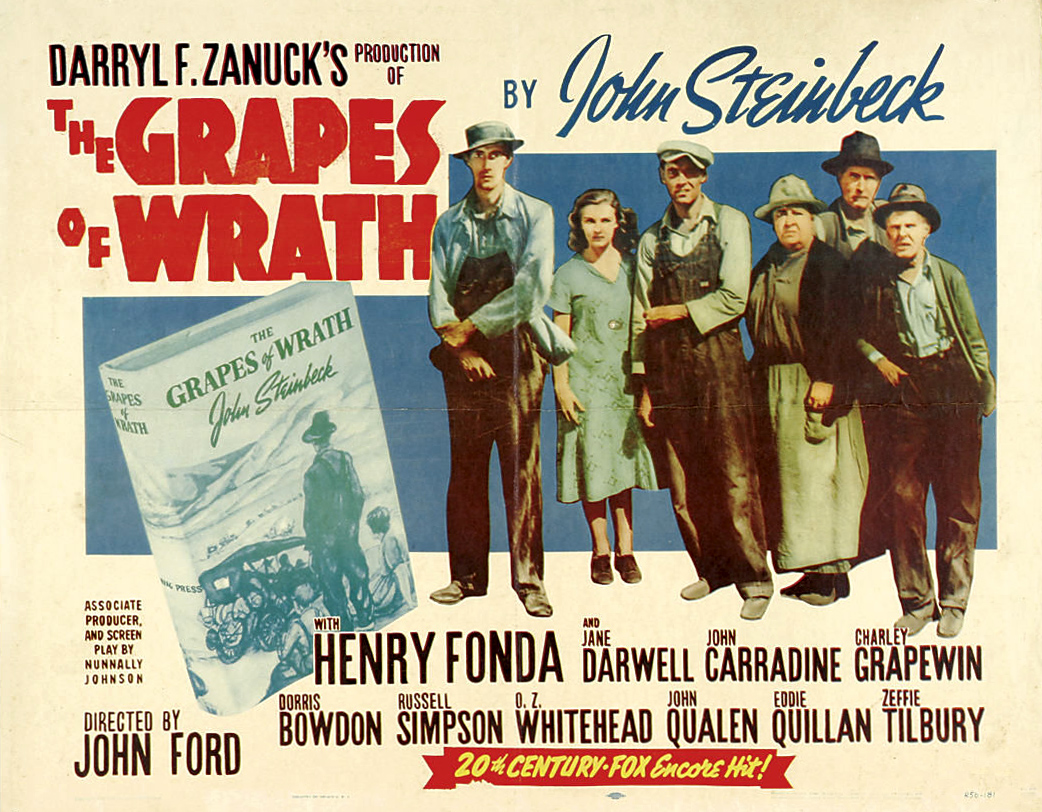
As the above poster indicates the motion picture was a production of Darryl F. Zanuck. Four years after the picture was released he became the head of 20th Century Fox. Over his career Zanuck produced 232 feature films between 1925 and 1973 and wrote 82 screenplays between 1922 and 1969.
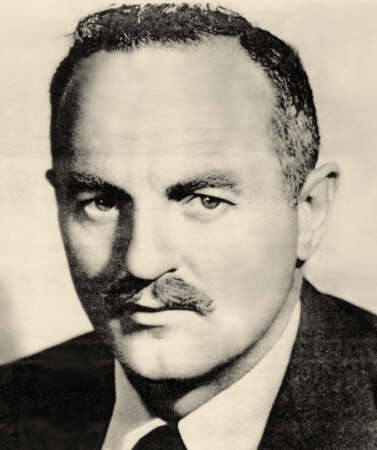
The motion picture was co-produced by the screenplay writer Nunnally Johnson. Johnson was nominated for the Best Adapted Screenplay Oscar for "The Grapes of Wrath". He produced 42 motion pictures between 1935 and 1959, but it was his 74 screenplays between 1927 and 1988 that he is best known for. Besides "The Grapes of Wrath" that group included 1942's "Roxie Hart", which would eventually become the musical "Chicago", the excellent Western from 1950 "The Gunfighter" starring Gregory Peck, 1951's "The Desert Fox: the Story of Rommel" that starred James Mason, the Marilyn Monroe, Betty Grable, Lauren Bacall feature "How to Marry a Millionaire" from 1953 and 1967's War drama "The Dirty Dozen" starring Lee Marvin.

The motion picture was Directed by John Ford. Between 1917 through 1976 For Directed 147 feature films including his Cavalry Trilogy of 1948's "Fort Apache" starring Henry Fonda and John Wayne, Wayne starred in the other two, 1949's "She Wore a Yellow Ribbon" and 1950's "Rio Grande" co-starring Maureen O'Hara. John Ford paired Wayne and O'Hara in 1952's "The Quiet Man" and 1957's "The Wings of Eagles". Henry Fonda had appeared in John Ford's 1939 "Drums Along the Mohawk" and the same year's "Young Mr. Lincoln" immediately before this feature.

Above John Ford, Jane Darwell and Henry Fonda on set for "The Grapes of Wrath".
There is only one starring role in the feature film and that's Henry Fonda as "Tom Joad", but the film has a surprising 9 supporting actors because of Steinbeck's novel. I already mentioned the work Fonda had done the year proceeding this motion picture for John Ford. He also appeared in three other motion pictures in 1939. They were "The Story of Alexander Graham Bell" starring Don Ameche and Loretta Young, "Jesse James" starring Tyrone Power as "Jesse" and Fonda as "Frank James" with a screenplay by Nunnally Johnson. An lastly an overlooked motion picture "Let Us Live" co-starring Maureen O'Sullivan. Henry Fonda would be nominated for the Best Actor Oscar, as "Tom Joad", loosing out to his best friend Jimmy Stewart for "The Philadelphia Story".
21-07-57%5D.JPG)
Actress Jane Darwell may not be remembered today, but her performances were all extremely powerful. As was her Supporting Oscar win for portraying "Ma Joad".
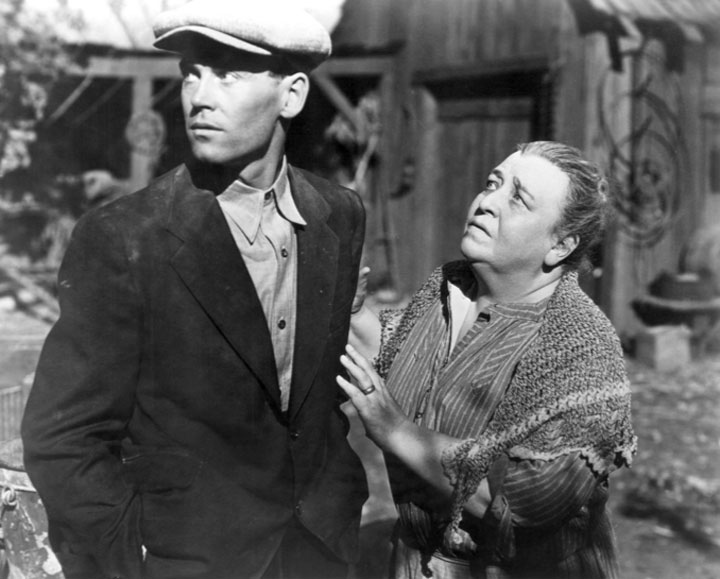
If you don't recognize Jane Darwell in this film. but you've seen Walt Disney's original 1964 "Mary Poppins". Darwell was "The Bird Lady". Between 1913 and the Disney motion picture, her last, the actress appeared in 210 on screen roles. Not to forgot her legitimate stage roles. Among her feature films were several with Shirley Temple including 1935's "Curly Top" and 1936's "Captain January". Then there was 1939's "Gone With the Wind" and"Jesse James" portraying Tyrone Power and Henry Fonda's mother. Besides "The Grapes of Wrath", Jane Darwell, also in 1940, was seen in "Brigham Young" starring Tyrone Power, "Chad Hanna" with Fonda and "The Oxbow Incident", another Henry Fonda picture, Directed by William A. Wellman.
The pivotal second male role of "Jim Casy" went to John Carradine.
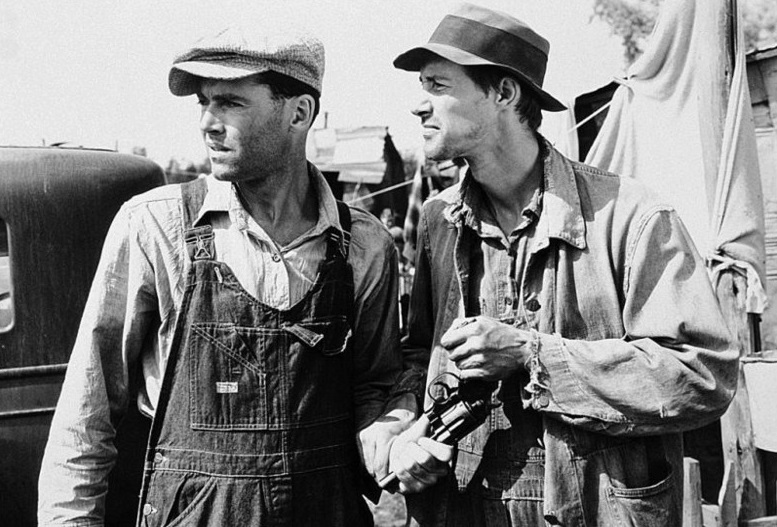
Shakespearean trained Carradine had been in motion pictures since 1930, but until 1935, blink, and you missed him. He was in Cecil B. DeMille's 1932 "The Sign of the Cross" and actually had three roles. The third was just "a voice in the coliseum mob", In 1933's "The Invisible Man" John Carradine was described as "Informer suggesting ink" and in 1934's "The Black Cat" the "Cult Organist". All without on screen credit. In the 1935 Frederick March and Charles Laughton "Les Miserables" John Carrdine had a small speaking role as "Enjioras".. Than back to non screen credited roles, if they weren't deleted, including 1935's "The Bride of Frankenstein". Then things changed starting with fifth billing in 1936's "White Fang" based upon the Jack London novel and another fifth billed role, in the same years, "Mary of Scotland" starring Katharine Hepburn and Frederick March.
Charley Ghapewin portrayed "William James "Grandpa" Joad". Grapewin's started motion picture acting in 1900. He portrayed "Gramp Maple" in 1936's "The Petrified Forest" starring Leslie Howard, Bette Davis and introducing Humphrey Bogart. In 1937 Charley Grapewin was in "Captains Courageous" alongside John Carradine. He played "Uncle Henry" in 1939's "The Wizard of Oz" and in 1941 was the lead in John Ford's version of Erskine Caldwell's "Tobacco Road".
Charley Grapewin is in lower left of the following still.

Dorris Bowdon had the role "Rosaharn".

Although Dorris Bowdon was fifth billed in "The Grapes of Wrath". She had only appeared four previous times on film and would be only in two more pictures for a total of seven. This was her third feature for Director John Ford. The others being from the previous year were "Drums Along the Mohawk" and "Young Mr. Lincoln".
Russell Simpson portrayed "Pa Joad". Simpson's face was familiar to many "B" Western audiences starting with silents in 1914, but also would appear in :"A" movies with a frontier setting. Such as two Errol Flynn films 1939's "Dodge City" and 1940's "Virginia City". For John Ford he was seen in both 1939's "Young Mr. Lincoln", the same years' "Drums Along the Mohawk" and 1959's "The Horse Soldiers". All among Russell Simpson's 246 roles.

O.Z. Whitehead was "Al Joad", Among other acting duties, mostly on the legitimate state, Whitehead was a member of the 'John Ford Stock Company". He would be seen in 1959's "The Horse Soldiers", 1962's "The Man Who Shot Liberty Valance"in which he portrayed a lollipop carrying school boy, because of his youthful looks as Whitehead was 51. On the other hand the actor portrayed "The Bishop of Durham" in 1968's "The Lion in Winter" starring Peter O'Toole as "Henry II" and Katherine Hepburn as "Eleanor of Aquitaine".

John Qualen was "Muley Graves". Character actor Qualen was a familiar face, even if his name wasn't, in 218 ,motion pictures starting in 1931. Among those films were 1940's Knute Rockne All American" featuring a young Ronald Reagan as "The Gipperr". 1942's "Casablanca", 1959's "Anatomy of a Murder" and 1962's "The Man Who Shot Liberty Valance".
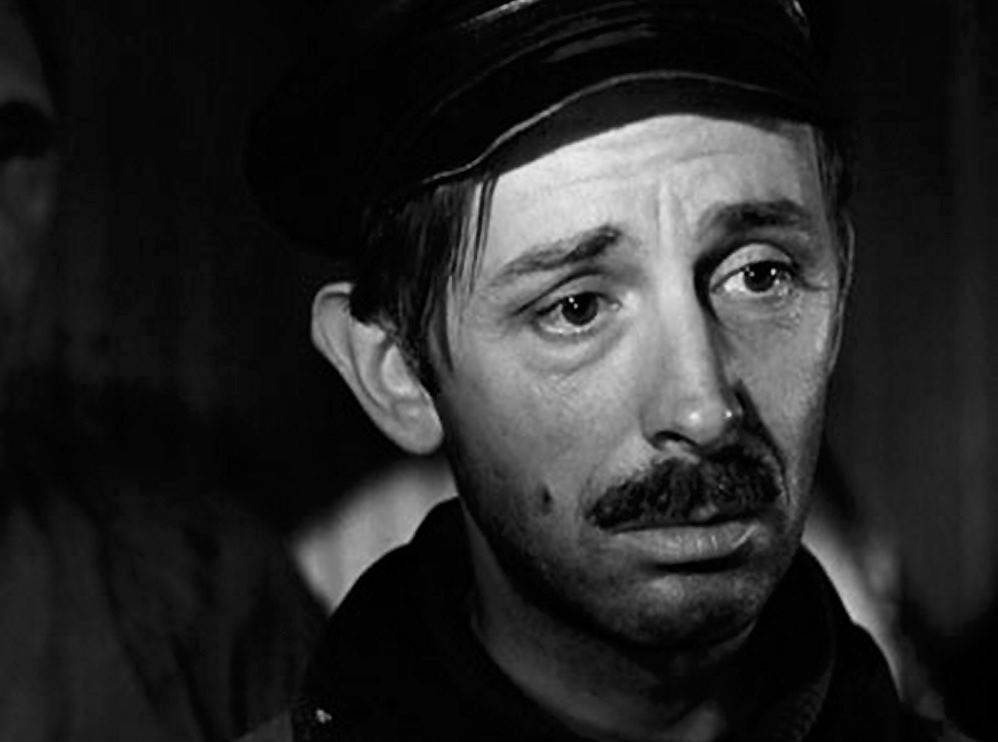
Eddie Quillan was in the role of "Connie Rivers". This was the actor's only major role. Most of his work were bit parts with characters called "Eddie".
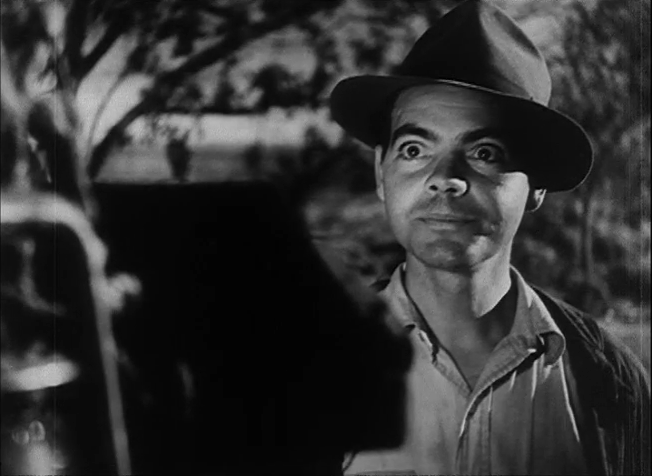
The last supporting actor was Zeffie Tilbury portraying "Grandma Joad". The British actress started film work in 1917 and ended her career in 1942 in the role of a "Fortune Teller". Her varied motion picture roles included the 1935 version of Charles Dickens "The Mystery of Edwin Drood" starring Claude Rains. In that film Tilbury's role was "The Opium Woman". The same year she was in nine other motion pictures including "The Werewolf of London" and Merian C. Cooper's "The Last Days of Pompeii". In the 1936 Laurel and Hardy comedy "The Bohemian Girl" Zeffie Tilbury was the "Gypsy Queen".

The screenplay opens with the release of "Tom Joad" from prison as he starts hitchhiking his way home to the family farm. On his journey home"Tom" meets itinerant ex-preacher ?Jim Casy".Who, at this point in "Cssy's" life, is observing the Great Depression's impact on his friends and neighbors. "Casy" has lost both his faith and the spirit of God, but he joins "Tom". The two men meet with "Muley Graves", using a flashback, "Muley" relates how the small farmers have been forced off their generational family farms by the deed holders.
"Muley", "Tom" and "Casy"arrive at the "Joad" family farm which is being taken over by the dead holder. The three join "Tom's" other eleven family members and decide to head for the "Promised Land" of California. The family loads everything they own and the family, itself, into a dilapidated 1926 "Hudson" Super Six Sedan that they have converted into a truck and leave Oklahoma for good.


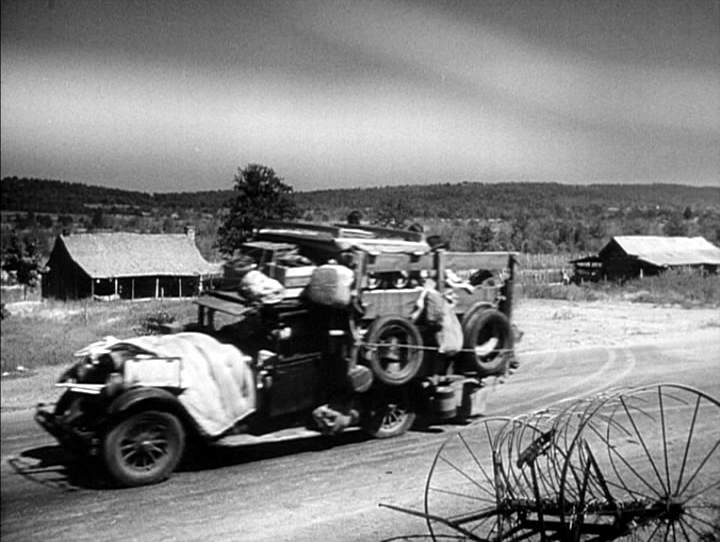
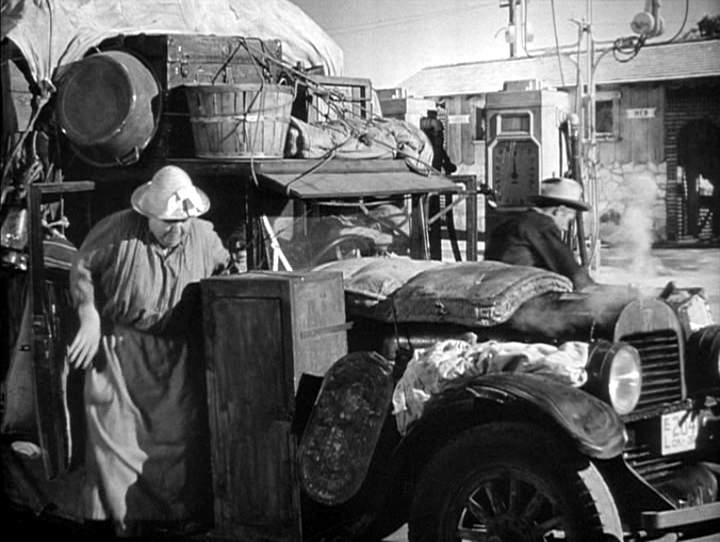
The images of the converted car was no Hollywood gimmick to tug at viewers sympathies, or one created by John Steinbeck. This was the reality for entire American farm families of the Great Depression era.
As the family travels west, along Route 66, "Grandpa Joad" becomes ill and dies.

He is buried alongside the highway, but to prevent people from believing his death was a suicide. Something that was happening over and over again. "Tom" takes a page from the family bible and writes information upon it and places the paper on his grandfather's body before he is buried.
Parking in a camp the "Joad" family meets a man coming from California. He laughs at their idea of a "Promised Land" and tells them that things are as bad there.

After the family reaches California two things immediately happen.

The first is that "Grandma Joad" now dies.The second is that both "Grandma's Son Noah" and her son-in-law "Connie" leave the family group. Reaching the first transient camp the family is surprised to find everyone hungry and as "Tom" states:
Sure don't look none too prosperous.
The family leaves that camp and arrives at the "Keene Ranch" finding work in the fields.
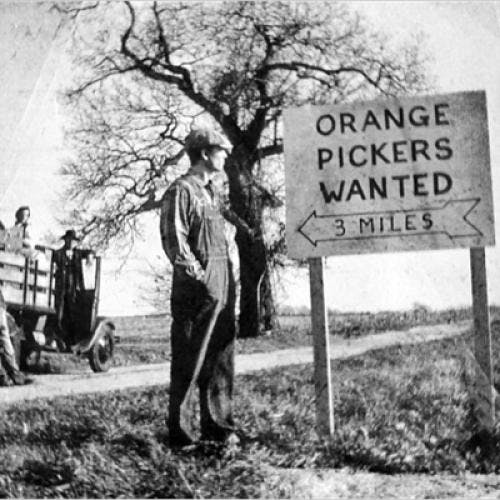

However, they soon discover the outlandish high prices for the food sold at the company store. The only one in the area that eat up their wages and more.

Later "Tom" and "Casy" hear about a meeting of workers who want to strike for better wages and working conditions.

The meeting is held at night in the woods near the ranch and the two friends go there. However, camp guards show up and a fight breaks out. "Casy" will be killed and "Tom" kills one of the guards, but suffers a serious facial wound making it easy to identify him. The family decide to leave the "Keene Ranch" to protect "Tom".

The "Joad" family reach the top of a hill and the converted cars engine overheats. They see the lights of another camp and decide to coast down the hill. The family now comes to a new type of camp run by the "Department of Agriculture". The camp is clean and has indoor toilets and showers. Which the "Joad" children had never seen before.
After seeing what the other camps are like and knowing that "Casy" had found a goal in life to fight for social reform. "Tom" decides to leave the family and continue "Casy's" cause. As he leaves the audience hears:
I'll be all around in the dark. I'll be everywhere. Wherever you can look, wherever there's a fight, so hungry people can eat, I'll be there. Wherever there's a cop beatin' up a guy, I'll be there. I'll be in the way guys yell when they're mad. I'll be in the way kids laugh when they're hungry and they know supper's ready, and when the people are eatin' the stuff they raise and livin' in the houses they build, I'll be there, too.That sequence is not the end of the film. After "Tom" has left the family decides to move on once more. It is "Ma Joad" who has Nunnally Johnson's closing lines:
I ain't never gonna be scared no more. I was, though. For a while it looked as though we was beat. Good and beat. Looked like we didn't have nobody in the whole wide world but enemies. Like nobody was friendly no more. Made me feel kinda bad and scared too, like we was lost and nobody cared.... Rich fellas come up and they die, and their kids ain't no good and they die out, but we keep a-coming. We're the people that live. They can't wipe us out, they can't lick us. We'll go on forever, Pa, cos we're the people.
One major element partly shown in the above stills is the striking black and white, light and shadows work of cinematographer Gregg Toland. His camera brings to life for audiences, like a painting, the Great Depression. Which those audiences had just lived through and some were still fighting to recover from.
What makes this motion picture odd was the fact that both Darryl F. Zanuck and John Ford were solid Right Wing Conservatives. The two making a motion picture based upon the work of an American writer, John Steinbeck, thought by many to be a Communist is an interesting reflection of America at the time. Some critics believe the rise of Hitler and the start of World War 2 may have contributed to this strange combination of political beliefs.
Darryl F. Zanuck was concerned about how the picture would be received in Right Wing Conservative Oklahoma. As it contained what might be considered a pro-Communist slants by Steinbeck. Zanuck actually sent Detectives to speak to the people there, because Oklahoma was a strong Red-Baiting State.
BOXCAR BERTHA released June 14, 1972
When you think about Depression Era Folk Hero Criminals. The names of Bonnie Parker and Clyde Barrow usually come to mind. As Hollywood has fictionalized their lives in many motion pictures and several documentaries about American Crime History contain their story.
Below the real Clyde Barrow and Bonnie Parker.

Hollywood first made a version of their life in 1958. This highly fictionalized story starred Dorothy Provine in "The Bonnie Parker Story" and "Clyde Barrow's" name was changed to "Guy Darrow". See my article on 1950's gangster movies I mentioned above.

Probably one of the best known Depression Era gangster films is 1967's "Bonnie and Clyde" starring Faye Dunaway and Warren Beatty.

The last film about the crime duo, as of this writing, was a television film in 2017. However, "Bonnie and Clyde" were not the only such couple during the Great Depression Era.
In 1972 Producer Roger Corman, 1955's "The Day the World Ended", 1957's "Not of this Earth" and 1958's "Machine Gun Kelly" starring an unknown Charles Bronson, Produced a very good motion picture about one other such couple.
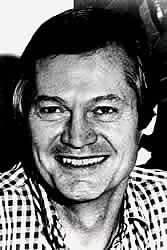
It was about the basically forgotten crime duo of Bertha Thompson and Bill Shelly entitled "Boxcar Bertha".
The motion picture was based upon "Sister of the Road: The Autobiography of Boxcar Bertha--as told to Dr. Ben Reitman" and written by Reitman.
The website "Goodreads" describes the book, still available, this way:
Another raging slab of real American history you're not likely to find in the textbooks. ...... Hobo jungles, bughouses, whorehouses, Chicago's Main Stem, IWW meeting halls, skid rows and open freight cars—these were the haunts of the free thinking and free loving Bertha Thompson. This vivid autobiography recounts one hell of a rugged woman's hard-living depression-era saga of misadventures with pimps, hopheads, murderers, yeggs, wobblies and anarchists.https://www.goodreads.com/book/show/680141.Sister_of_The_Road
The same review has this description of the author:
Dr. Ben Reitman (1880–1942)—hobo, whorehouse physician, anarchist agitator, and tour manager/lover of Emma Goldman, was a mighty interesting character in his own right.
The screenplay was written by the husband and wife team Joyce H. and John William Corrington known for writing scripts for television Soap Operas. They wrote the screenplay for Roger Corman's 1971 "Von Richthofen and Brown". Along with the screenplay for 1971's "The Omega Man" the second version of Richard Matheson's novella "I Am Legend" and would write 1973's "Battle for the Planet of the Apes".
For his Director, Roger Corman choose Martin Scorsese. This was Scorsese's second feature film in the capacity. Although he had Directed one documentary for the "United States Information Agency" and three shorts. The following year Martin Scorsese Directed his third motion picture "Mean Streets" and the rest is history.

Actress Barbara Hershey was "Bertha Thompson". Hershey had been acting on television since 1966 and her first motion picture was co-starring with Glenn Ford and Carolyn Jones in 1969's "Heaven With A Gun". Hershey followed that feature with a popular youth orientated movie, at the time, the 1969 drama "Last Summer" and shocked audiences in the title role of 1970's "The Baby Maker". Barbara Hershey's latest appearance was last year, 2018, in a three part episode of television's "The X-Files".


Portraying "Bill Shelly" was David Carradine. Among his television work had been the short 17 episode season of series "Shane" in 1966. Where the actor portrayed the role made famous by Alan Ladd. In 1969 Carradine appeared in three Westerns including the already mentioned "Heaven With A Gun". The other two were "Young Billy Young" starring Robert Mitchum and Angie Dickinson and another Mitchum Western "The Good Guys and the Bad Guys" co-starring George Kennedy. In February 1972 David Carradine appeared in the first of 63 episodes of the television series "Kung-Fu".


Barry Primus portrayed "Rake Brown". He had portrayed Herman Goering in Corman's "Von Richthofen and Brown". The actor had been appearing on television shows since 1962. Primus portrayed Director Nicholas Ray, "Rebel Without A Cause", in the 2001 made for television movie "James Dean".

Bernie Casey portrayed "Von Morton:. His first motion picture was 1969's "Guns of the Magnificent Seven". In the made for TV Horror movie, 1972's "Gargoyles", the actor was the "Gargoyle". While in 1976 Casey portrayed "Dr. Henry Pride" in "Dr Black, Mr. Hyde". Then in 1983 he was "Felix Leiter" to Sean Connery's return to "James Bond" in "Never Say Never Again" and fans of 1989's "Bill and Ted's Excellent Adventure" know him as "Mr. Ryan".


The villain of the piece "H. Buckram Santoris" was portrayed by David Carradine's father John. Below a photo of father and son on the set.

Two years before this
feature Roger Corman had Produced and Directed Shelley Winters as another Depression Era gangster "Ma Barker". The picture was
entitled "Bloody Mama" and featured unknowns
Bruce Dern and Robert De Niro. The style was fast action and little character
development and Corman was thinking the same for "Boxcar
Bertha". However, he underestimated his young Director even on a
budget of 600,000 1972 dollars equal to, as of this writing, $3,617,770
dollars.
Martin Scorsese and Cinematographer John M. Stephens recreated Depression Era Arkansas beautifully. Stephens started out on the Hanna-Barbera 1969 children's television series "The Banana Splits Adventure Hour" and moved to such films as the controversial story of a returning Vietnam Veteran 1971's "Billy Jack", 1988's "Midnight Run" starring Robert DeNiro, 1996's Science Fiction feature "The Arrival" starring Charlie Sheen and 1997's "Conspiracy Theory" starring Mel Gibson and Julia Roberts.
Critic Roger Ebert wrote on July 19, 1972 that:
Martin Scorsese and Cinematographer John M. Stephens recreated Depression Era Arkansas beautifully. Stephens started out on the Hanna-Barbera 1969 children's television series "The Banana Splits Adventure Hour" and moved to such films as the controversial story of a returning Vietnam Veteran 1971's "Billy Jack", 1988's "Midnight Run" starring Robert DeNiro, 1996's Science Fiction feature "The Arrival" starring Charlie Sheen and 1997's "Conspiracy Theory" starring Mel Gibson and Julia Roberts.
Critic Roger Ebert wrote on July 19, 1972 that:
Boxcar Bertha" is a weirdly interesting movie and not
really the sleazy exploitation film the ads promise. It finds its inspiration
in the exploits of Boxcar Bertha Thompson, an outlaw folk hero who operated in
Arkansas during the Depression
Adding:
I have the notion that Roger Corman, American-International's
most successful producer of exploitation films, sent his actors and crew South
with the hope of getting a nice, simple, sexy, violent movie for the summer
trade. What he got is something else, and something better.
Director Martin Scorsese has gone for mood and atmosphere more than
for action, and his violence is always blunt and unpleasant -- never liberating
and exhilarating, as the New Violence is supposed to be. We get the feeling
we're inhabiting the dark night of a soul.
https://www.rogerebert.com/reviews/boxcar-bertha-1972
When we first meet 16 year old"Bertha Thompson". She is at a farm where her father is to fly a crop duster that may not be very safe. It proves as such and he dies in a crash.

Hysterical "Bertha" with the help of her father's mechanic "Von Morton" and a labor organizer, who happens to be talking to railroad workers nearby, "Bill Shelly", attacks her fathers boss. Several days later the now alone "Bertha Thompson" jumps onto a train box car with only her clothing heading anywhere, but the place her father was killed.
At a train stop the following day she spots "Bill" "preaching" to a group of railroad workers. "Bill" and the railroad workers are under the observation of the local police. He is attempting to get the workers to Unionize. When under orders and paid off by "H. Buckram Santoris" the police move in and a fight breaks out.

When we first meet 16 year old"Bertha Thompson". She is at a farm where her father is to fly a crop duster that may not be very safe. It proves as such and he dies in a crash.

Hysterical "Bertha" with the help of her father's mechanic "Von Morton" and a labor organizer, who happens to be talking to railroad workers nearby, "Bill Shelly", attacks her fathers boss. Several days later the now alone "Bertha Thompson" jumps onto a train box car with only her clothing heading anywhere, but the place her father was killed.
At a train stop the following day she spots "Bill" "preaching" to a group of railroad workers. "Bill" and the railroad workers are under the observation of the local police. He is attempting to get the workers to Unionize. When under orders and paid off by "H. Buckram Santoris" the police move in and a fight breaks out.


"Bill" gets "Bertha" away from the fight, buys her a meal, and then the two enter a boxcar.


There "Bill" seduces the 16 year old "Bertha" and when she awakes. Is again alone as "Bill" is gone and left her some money. "Bertha" next moves to a hobo encampment where "Rake Brown", a gambler, is holding a poker game.
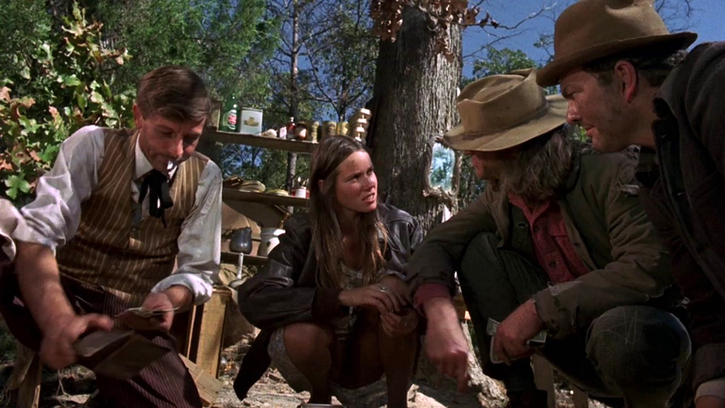
"Bertha" takes the money from "Bill", wins the game, and finally gets the very silent "Rake" to say something a mistake on his part. As immediately the "Southern Hobo's" hear a "Yankee" accent and run the two out of the camp.
"Rake" gives "Bertha" a sense of security she has not had until then. In return she teaches him a protective"Southern Accent", becomes a sexual partner, and joins him in fleecing wealthy men. Things go wrong one day and the two jump into a passing boxcar. Inside is "Bill" and the three becomes friends. There are other workers in the freight box car looking for work somewhere, but when the train is stopped by the police and arrests are made. "Bertha" manages to escape, but "Rake" and "Bill" are taken to a jail. There "Bill" finds "Von" and starts to speak to him, but the Southern jail guards call him a "nigger lover" and beat "Bill" up. The three are taken to a work gang.
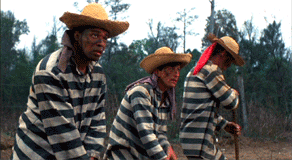
Days later "Bertha", posing as a women in distress, distracts the guards on the work gang and the three men escape with her in a stolen car.

The "Boxcar Bertha" gang has been created as "Bill" skillfully avoids the pursuing Sheriff and his men. Later the car breaks down near a railroad track and their first train robbery takes places. By pushing the broken down car onto the train tracks blocking an on coming freight and rob it of $12,000 dollars equating to $181,105 at the time of this writing.


They four flee to a hideout and divide the money. The following day "Rake" gets a newspaper and returning reads ot to the others. The newspaper is claiming the Trio murdered an attorney. In the article "Rake" is called a "coward" and "Bertha" a "whore". "Bertha" protests that the charges are false, but there is nothing they can do. "Rake" and "Von" realize that they are now forced into a life of crime, but "Bill" doesn't and leaves with his share. He takes his money to the local Union Hall, but they refuse it over how it was obtained. "Bill" returns to the other three and the gang make their first bank robbery.

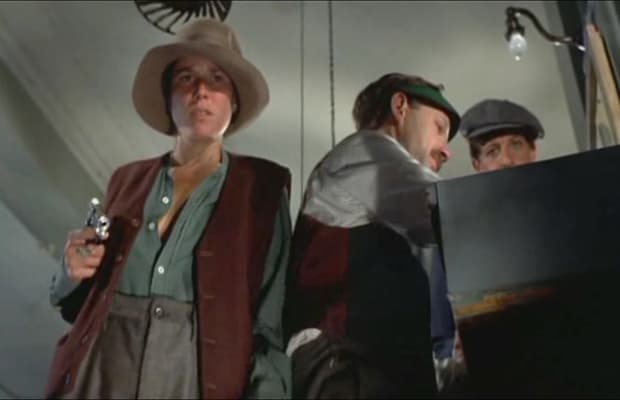
During the robbery "Bill", ever the Worker Rights advocate, insists that bank raise their employees pay by ten dollars. The group next decides to rob the trains of "The Reading Railroad". They figure to terrorize the owner "H.Buckram Sartoris" into running hobo's off his trains. "Sartoris" thinks otherwise and hires two sadistic railroad detectives, the "McIver's", to go after the group.

The four next show up at a party being given by "Sartoris" and rob the guests.

Being overly confident "Bertha", "Bill", "Rake" and "Von" decide to kidnap "H. Bucram Sartoris" off his own train. This will be their mistake as waiting for them are the "McIver's" and other hired men in a trap.
"Bertha" is able to escape, but "Rake" is killed. "Bill"" and "Von" are captured and sent to jail. The guards brutally beat up "Bill" for being a "Union Organizer" in the past.
"Bertha" now starts to work in a brothel and one night hears a harmonic player. She discovers that it is "Von" performing at a Black Night Club. He informs her that "Bill" escaped jail, but is very ill and takes "Bertha" to the shack "Bill" is hiding out at
The "McIver's" show up and brutally beat up both "Bill" and "Bertha". They than crucify :Bill" on the side of a box car.


"Von" realizing what is happening goes for a shot gun and kills both "McIver's".

The film ends with "Bertha" running after the train begging it not to take "Bill" away from her.

BOUND FOR GLORY released December 5, 1976
This land is your land and this land is my land
From California to the New York island
From the redwood forest to the Gulf Stream waters
This land was made for you and me
As I went walking that ribbon of highway
I saw above me that endless skyway
Saw below me that golden valley
This land was made for you and me
Thus begins the classic Folk Song by Woody Guthrie

Woodrow Wilson Guthrie was born July 14, 1912 and over his life ending on October 2, 1967. He wrote some of the most memorable American Folk Music.

In 1943 "Woody" published a partly fictionalized autobiography "Bound for Glory".
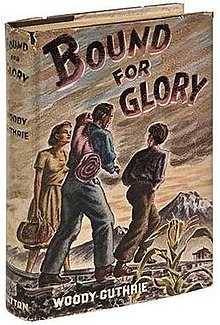
The motion picture version of the book was Directed by Hal Ashby. Ashby was a product of the Vietnam War Era. While working at Metro-Goldwyn-Meyer he became friends with a messenger boy named Jack Nicholson. Ashby started working as a film editor for Producer/Director Norman Jewison and edited the Black Comedy "The Love One" in 1965.
Hal Ashby's first position as a Director indicated the direction he would go. It was 1970's "The Landlord" about a spoiled White rich boy portrayed by Beau Bridges. Who has to face his African American tenants and his own racial prejudice. Ashby's other work would include 1973's "The Last Detail" starring Nicholson and Randy Quaid, 1975's "Shampoo" starring Warren Beatty, Julie Christie and Goldie Hawn.
After "Bound for Glory" Hal Ashby would make 1978's "Coming Home". He was nominated for the Academy Award for Best Director. The feature was nominated for Best Picture and it won Best Actor Oscars for Jane Fonda and Jon Voight and a nomination for Bruce Dern as Supporting Actor. This was the realistic hard hitting story of a women, whose husband is in Vietnam, unexpectedly falling in love with a paraplegic Vietnam Veteran with problems adjusting to his condition.
.

The screenplay for "Bound for Glory" was by Robert Getchell. Before this picture Getchell wrote his first screenplay for the 1974's "Alice Doesn't Live Here Anymore" which starred Ellen Burstyn and Kris Kristofferson. He turned that successful motion picture story into a popular 1970's television series entitled "Alice". In 1981 Getchell wrote the screenplay for "Mommie Dearest" that starred Faye Dunaway as Joan Crawford. His last screenplay was "The Client" that starred Susan Sarandon and Tommy Lee Jones.
As this features screenplay was based upon the book by Woody Guthrie. With the exception of his wife, Mary, all the characters are fiction, but the situations are real ones.
The great Cinematographer Haskell Wexler won the Oscar for his imagery. Wexler had filmed, among other work, prior to this feature 1965's "The Loved One", the Richard Burton and Elizabeth Taylor 1966 "Whose Afraid of Virginia Woolf ", 1967's "In the Heat of the Night" starring Sidney Poitier and Rod Steiger, 1968's original "The Thomas Crown Affair" starring Steven McQueen and Fate Dunaway, his own 1969 "Medium Cool", which featured the unexpected footage of the Democratic Convention riots in Chicago, and 1975's "One Flew Over the Cuckoo's Nest" starring Jack Nicholson and Louise Fletcher.
Below Haskell Wexler and Hal Ashby on the set for "Bound for Glory".


Haskell Wexler's photography recreated the Dust Bowl that was Oklahoma.
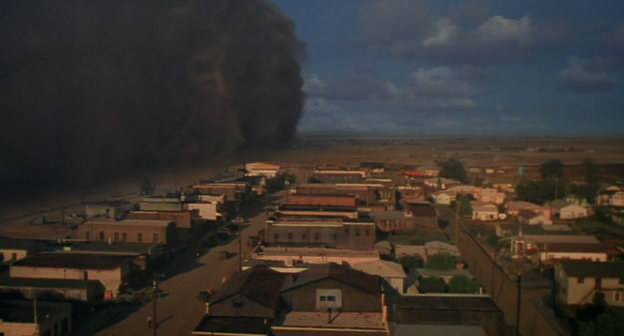
The cast was headed by David Carradine as Woody Guthrie.
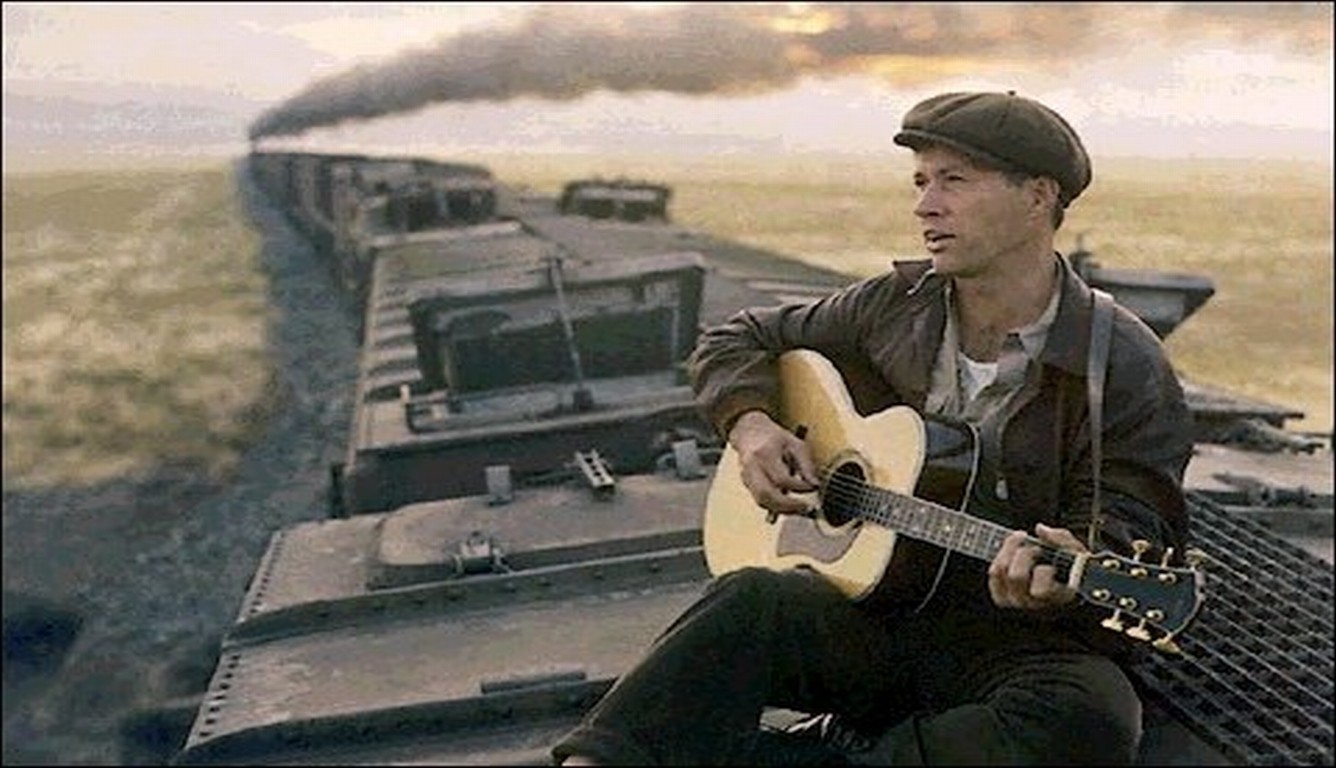
The excellent Carradine was Director Ashby's last choice. Dustin Hoffman and Jack Nicholson turned down the role and actor Tim Buckley, a folk, jazz, psychedelia and funk singer, was to have portrayed Woody originally, but he died from a drug overdose. Richard Dreyfuss was considered for the role, but negotiations didn't really start. Finally Hal Ashby decided to cast David Carradine whom he had turned down earlier. Writer Aljean Harmetz quoted Ashby in his 1976 work "Gambling Upon a Film About the Great Depression":
He had the right rural look and the musicianship, And he had a ‘to hell with you’ attitude.Portraying the one real person in the story, Mary Jennings, Woody Guthrie's wife, was Melinda Dillon. She also portrays a singer named "Memphis Sue" later in the film.


Dillon portrayed "Jillian Guiter" the mother of the little boy in Steven Spielberg's 1977 "Close Encounters of the Third Kind". Hal Ashby suggested her for the role three days prior to Spielberg beginning shooting. Ten years later she was "Nancy Henderson" in "Harry and the Hendersons".
Ronny Cox portrayed "Ozark Bule".

Working mostly on television in 1972 Cox became one of the group with Jon Voight and Burt Reynolds in "Deliverance". Although he continued to work mainly on television Ronny Cox was in 1984's "Beverly Hills Cop", the original 1987 "RoboCop" and the original 1990 "Total Recall".
Portraying the totally fictional rich young women "Pauline" was Gail Strickland.

Strickland started her acting career in two episodes of Dan Curtis' television Horror soap opera "Dark Shadows" in 1969. Her first feature film was fifth billing in the Paul Newman and Joanne Woodward 1975 "The Drowning Pool". Strickland was mostly seen on television through 2008. However, she was also in Michael Douglas and Annette Bening 1995 "The American President".
Below Randy Quaid was "Luther Johnson" and Elizabeth Macey is his wife "Liz".

Randy Quaid prior to this picture was already making a name from himself in some very interesting feature films. This started in 1971 with his first appearance in "The Last Picture Show" and followed that with 1972's "What's Up Doc?" starring Barbara Streisand and Ryan O'Neal. Next it was 1973's Lolly-Madonna XXX" and Hal Ashby's "The Last Detail" with Jack Nicholson and just prior to this picture 1976's "The Missouri Breaks" with Marlon Brandon and Jack Nicholson.
Elizabeth Macey only has three other roles to her credit.
Before I go into the screenplay I want to once again quote Roger Ebert on this motion picture:
Ashby and Wexler recreate the Depression years so well, see them so faithfully; that the movie actually becomes a historical document. If we want to know what that decade looked like, this is the film to come to. There is, for example, that matter of the diner where Woody gets his first square meal in California. “Airways Dinette,” it's called, and it's a white frame building on wheels that has stubby wooden wings and fake propellers; we see it just for a second but it's the sort of detail the movie's filled with.
And then there's the look of the small Texas towns, the California fruit fields, the Main Streets and back roads and railway yards. The film opens in a gas station in Woody's home town; he sits around with a few friends and the sun beats down and the flies buzz and we can almost smell the dust. A stranger drives up and buys a nickel Coke, and we can taste it. The whole movie's seen that well, especially in its most spectacular moments.
https://www.rogerebert.com/reviews/bound-for-glory-1977
The screenplay:
The two hour and twenty-seven minute feature film is a series of episodes in the life of Woody Guthrie condensed from the episodic fictionalized autobiography he wrote. When the audience sees Woody, after the above mentioned gas station sequence, with his wife and family he is a sign painter. Not being able to make ends meet. He keeps hearing about that better life in California and one night, writes a note, leaves his family and hops on a freight train and follows that by hitchhiking as a hobo on Route 66..



Woody arrives in California without a real idea what to do next.
.


He meets "Ozark Bule" at an immigrant camp. Where he discovers entire families attempting to make a living by working for landowners picking their crops. It is obvious to Woody that the workers are being ill treated, but what can he do? "Bule" writes and sings Folk songs about workers rights and at times is a Union organizer. With their mutual love of music the two join to fight against the greedy farm owners.


The two are being harassed by the so-called "Guards" on the farms and in the fields, but they continue on. Below the two join other musicians in a concert for prisoners.
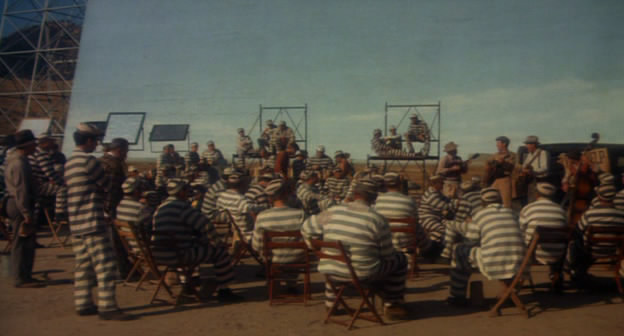
As the two continue they start to get gigs on radio and Woody Guthrie becomes a very popular singer. The two are joined by "Memphis Sue".


At this point in the screenplay Woody meets wealthy "Pauline" and their have a short affair, before he finally brings his family from Oklahoma to a nice California middle class home. However, Woody is having problems conforming to what the management of the radio station expect from a singer on their programs. In this case it is the lyrics of his songs which clearly attack the injustice and brutality he has witnessed in the fields of California. These problems starts to add pressure to Guthrie's family life and once again he leaves his family and heads to New York to appear on their radio stations.The motion picture ends with him on a boxcar singing "This Land Is Your Land".
Reality Check:
While both the book and motion picture made from "Bound for Glory" are both very good in there own right. Here are some facts in the life of Woodrow Wilson Guthrie never mentioned in either.
He was named for Woodrow Wilson the Governor of New Jersey and Democratic candidate for President.
His father Charles was a member of the newly reborn Ku Klux Klan. At the age of 7 Woody's older sister Clara died after setting her dress on fire. His father was severely burned in another fire and his mother, Nora, had Huntington's Disease and by his 14th birthday would be committed to an Oklahoma Hospital for the Insane.
At the age of 19 Woody Guthrie married Mary Jennings and the couple had three children. Bill would die in an automobile accident at the age of 23. Their two daughters Gwendolyn Gail and Sue, born two years apart, would die of their grandmother's Huntington Disease and both at the age of 41. In 1940 Woody and Mary divorced.
From 1945 into 1953 Woody was married to Marjorie Greenblatt. The year they divorced Woody Guthrie married his third wife, Anneke Van Kirkland until their divorce in 1956.
Woody Guthrie fathered eight children including Arlo Davy Guthrie. Who became a Folk Singer and writer like his father. Arlo's most famous composition was 1967's Alice's Restaurant Massacre" that was turned into a movie with him in 1969.

During World War 2 Woody Guthrie believed performing his anti-fascist songs was the best way to contribute to the war effort. However, a friend convinced him to join the Merchant Marines and Woodrow Wilson Guthrie served as a dishwasher and mess men on several ships.His last ship took army troops to the D-Day, June 6, 1944, invasion. On its way back to the England the ship was torpedoed by a German submarine, but stayed afloat.
Composer Irving Berlin wrote "God Bless America" during World War One. He rewrote it during World War Two. Woody Guthrie criticized the song as being a religious prayer and in 1940 wrote "Good Blessed America for Me". It was his protest response to the Berlin song.
Below is a copy of the original lyrics and cross outs of "God Blessed America for Me". As it was renamed and turned into "This Land Is Your Land".
This land is your land, and this land is my land
Below are a four actual photos of America during "The Great Depression":
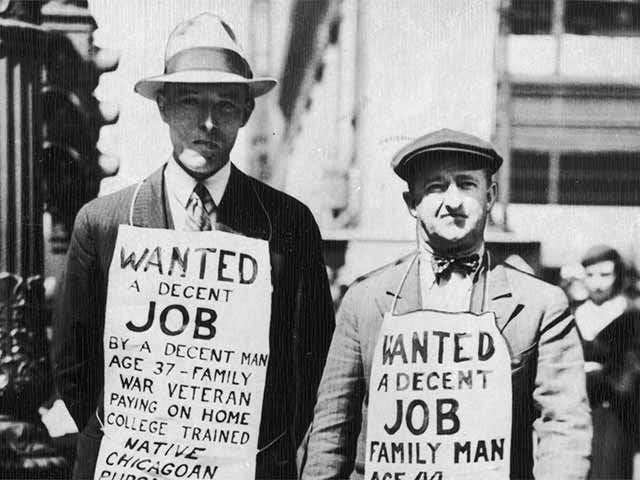
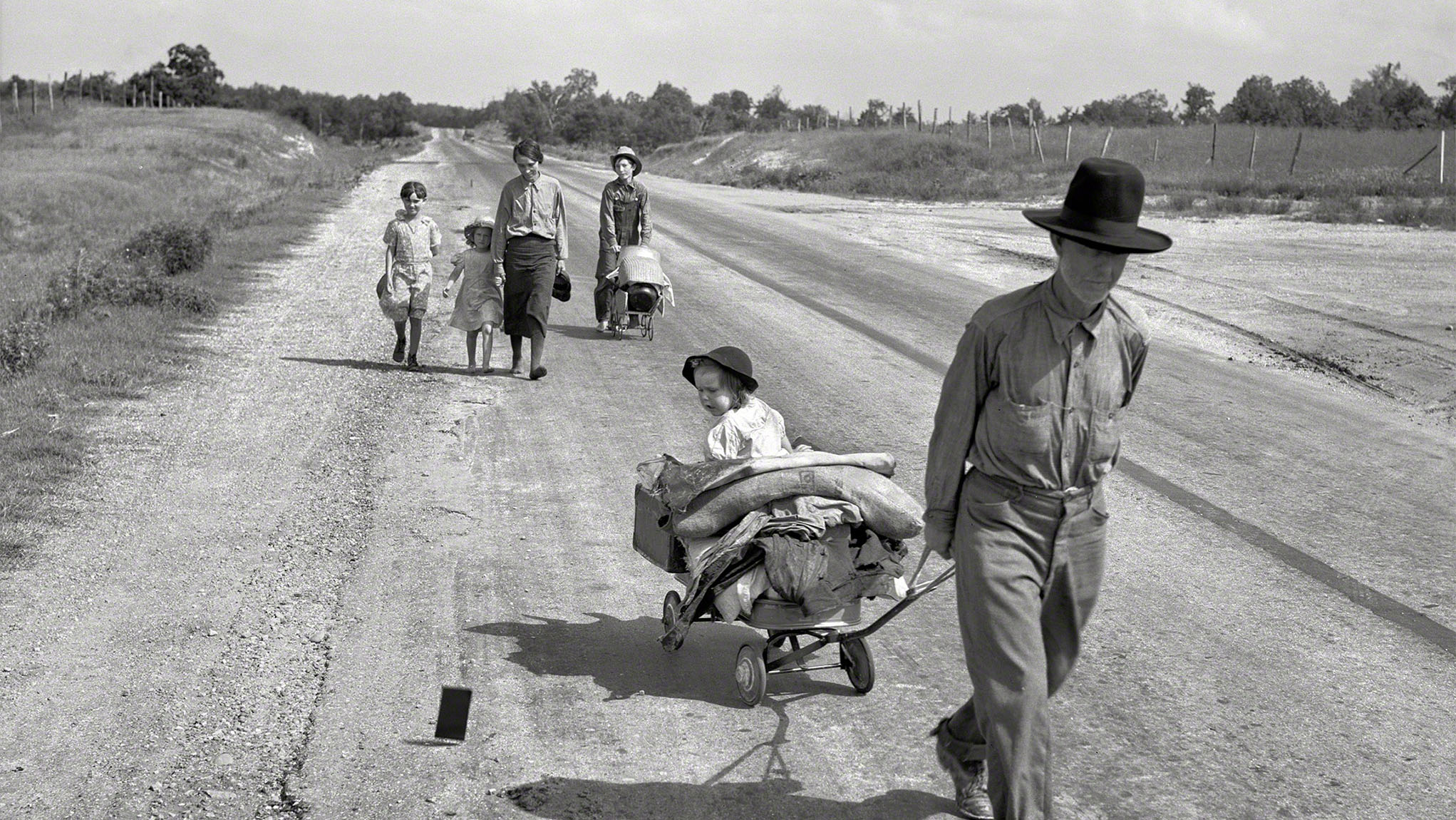



.jpg)


No comments:
Post a Comment